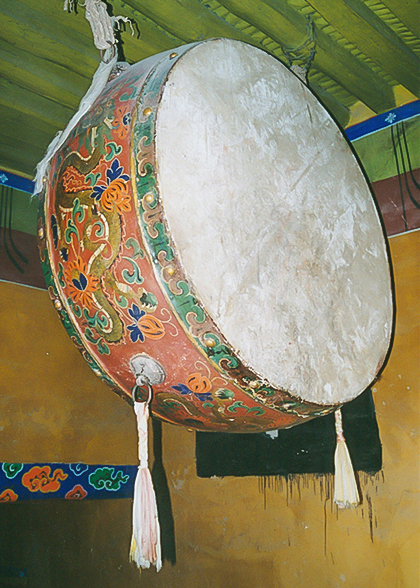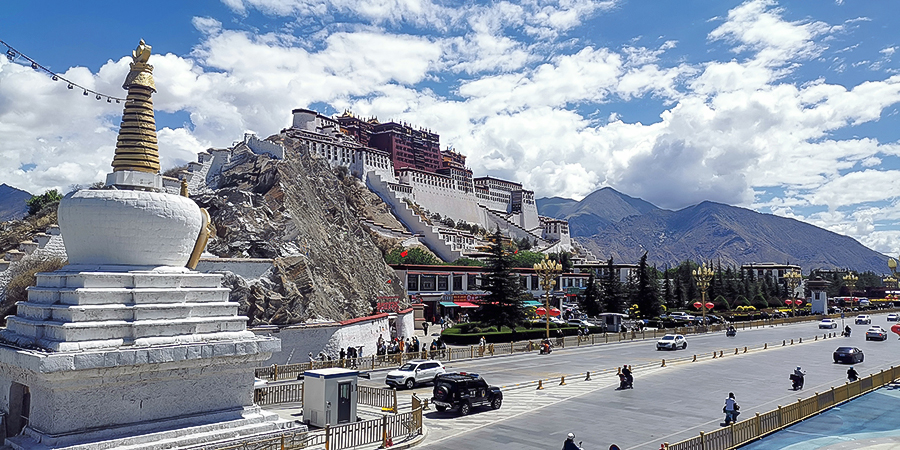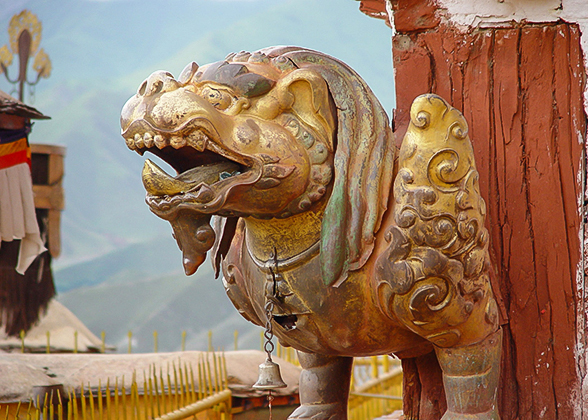The Potala Palace, the center of
Tibetan religion, politics, history and art, is really a local history museum. Collections in Potala Palace covers the works from the past 300 years and include over 2,500 sq meters (about 2,990 sq yards) frescoes, nearly 1,000 stupas, over 10,000 sculptures and nearly 10,000 Thangka paintings. The collection also includes paintings, wood carvings, classic scriptures, gold wares, jade wares and local crafts that reflect the wisdom and intelligence of the Tibetans.
Funerary Stupas
Funerary stupas here are built to preserve the remains of the Dalai Lamas upon their death. At present, there are eight luxurious stupas, one for each Dalai Lama except the sixth one who was dismissed. The funerary stupas differ in size but have the same structure consisting of the top, body and base. The top with 13 steps is embellished with patterns of sun, moon and fire wheel. The body of the stupa preserves the remains of the Dalai Lamas. All of the stupas are decorated with gold and gems. The most magnificent one is that of the fifth Dalai Lama. It stands nearly 15 meters (about 49 ft) high, costing a lot of money and decorated with 15,000 pearls, carnelians and gems.
Frescoes
An art corridor contains over 2,500 sq meters (about 2,990 sq yards) of frescoes which took nearly 200 people over 10 years to complete. These frescoes portray historical figures, religious legends, Buddhist stories, folk customs and architectures.
The frescoes preserved here portray some historical figures of great significance. The most important portraits include Three Kings of ancient Tibet, Dalai Lamas, Panchen Lamas, Wencheng Princess of the
Tang Dynasty (618 - 907), Chizun Princess from Nepal and Sanggye Gyatso (a famous politician and scholar in the local history). They also include paintings of the Wencheng Princess heading for Tibet, the fifth Dalai Lama meeting with the Emperor Shunzhi of the
Qing Dynasty (1644 - 1911) and the thirteenth Dalai Lama meeting with the Emperor Guangxu and the Empress Dowager Cixi of the Qing Dynasty.
Most of the religious frescoes are scroll paintings: several paintings are laid out in a line with a Buddha or a Bodhisattva as the center and the Buddhist stories are inscribed around the portraits. The frescoes about architecture show the construction of the Jokhang Temple (built in honor of the Chizun Princess coming to Tibet), the Potala Palace and other magnificent Buddhist temples.
Thangkas
A Thangka is a kind of painted scroll. It is usually painted on the thin silk, cloth or paper and mounted with colored damasks. The inscriptions are usually about religious figures, historical events and doctrines, including the Tibetan astronomical calendar and medicine. So far, nearly 10,000 Thangkas have been preserved in the palace.
Carvings and Paintings
The main hall contains delicately carved beams and attractively painted rafters. There are many patterns, such as clouds, curly grass, pomegranate blossom and some Sanskrit. The carvings are divided into relief and semi-circular engraving, with various paintings decorated on. The background colors are scarlet, gold and orange with some cold colors, such as green and blue for accent.
Sculptures
The sculptures here combine the art skills of Han Chinese, Indians and ancient Nepalese. The collection includes metal statues, colored clay sculptures, wood carvings, and stone carvings. The majority is intricately carved from gold, silver, copper and iron. They vary in size from over 10 meters (about 32.8 ft) to only a couple of centimeters.
Many famous and valuable sculptures can be found in the Dharma Cave, the center of the Red Palace, including the statues of Songtsen Gampo, Wencheng Princess, Chizun Princess and Luk Tung Chan (Ludongzan). A statue of Guanyin Bodhisattva stands in the Saint Chapel. “The Best of the Three Realms” (Sasum Namgyal) preserves the portrait of Emperor Qianlong of the Qing Dynasty and an 11-faced Guanyin statue.
Other Collections
 |
| Drum in Potala Palace |
Gold and jade seals, gold booklets are preserved in the palace. Most of them were presented as gifts to Dalai Lama by the emperors in the Qing Dynasty and are carved with characters of Manchu, Chinese, Tibet and Mongolia.
The Potala Palace also has over 2,500 volumes of Buddhist classic scriptures including the precious Pattra-Leaf Scriptures and Kangyur Scriptures, which were written with liquid gold. The Dabanruo Scriptures, as part of Kangyur Scriptures, were presented by Emperor Qianlong in the Qing Dynasty to the seventh Dalai Lama. The Four Heavenly Kings are carved in color on the front page of the Dabanruo Scriptures. There are also many classic books about Buddhism, medicine, and astronomy. These books are of great value for researching the economy, politics, history and culture of Tibet.
The numerous valuable collections preserved in the palace, including gold and silver wares, porcelain, jades, artifacts, Tibetan blankets, prayer flags and other local handicrafts, add local artistic style.

See general introduction to
Potala Palace
- Last updated on Jul. 12, 2024 by Gabby Li -






